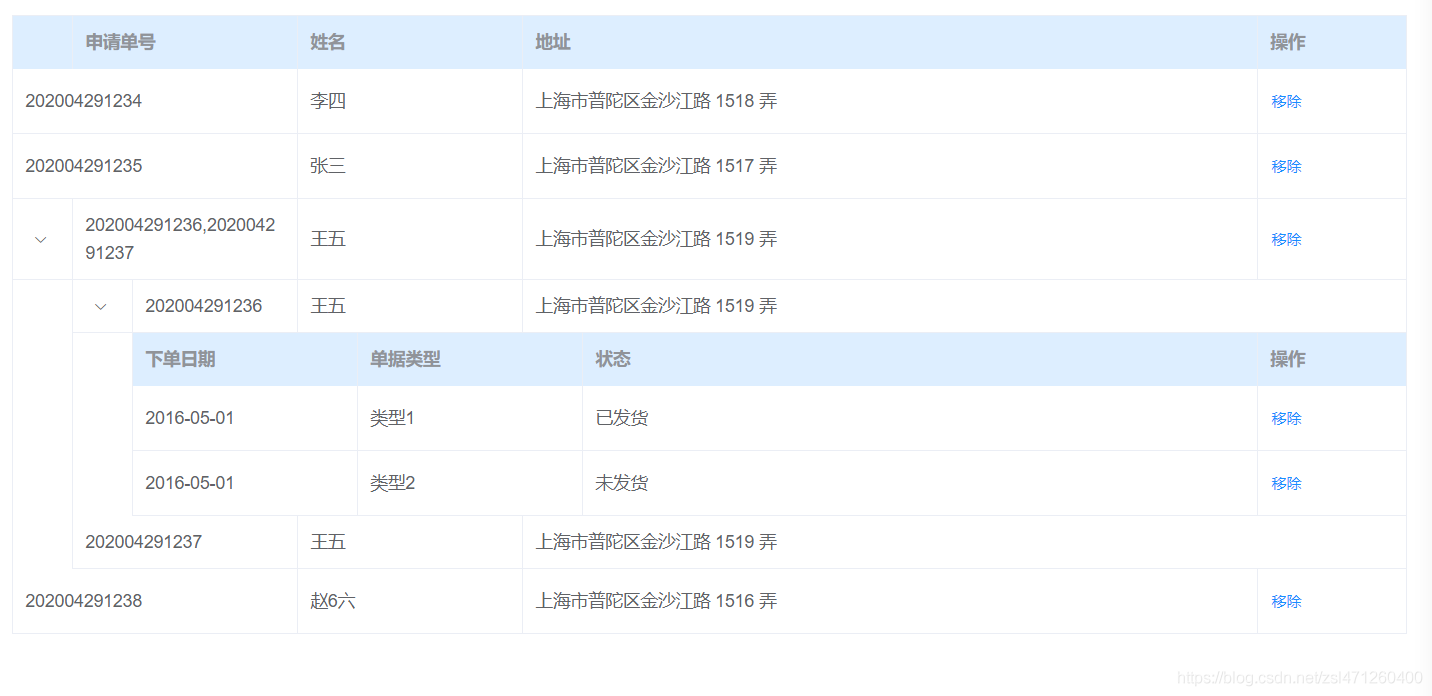element table多层嵌套显示的实践
有个需求是一个列表,里面包含多个单子,每个单子可以是唯一,也可以是多个合并之后的,而且每个单子下面显示的是另外一个表格,来上图

每行的操作还不一样,然后通过官网的一些例子总结了一下合并代码
<template>
<div class="app-container">
<div>
<el-table
:data="tableData"
style="width: 100%;margin-bottom: 20px;"
:span-method="arraySpanMethod"
row-key="id"
border
>
<el-table-column type="expand">
<template slot-scope="props">
<el-table
class="table-in-table"
:show-header="false"
:data="props.row.datas"
style="width: 100%;"
row-key="id"
:span-method="arraySpanMethod"
border
>
<el-table-column type="expand">
<template slot-scope="props">
<el-table
class="table-in-table"
:data="props.row.datas"
style="width: 100%;"
row-key="id"
border
>
<el-table-column prop="date" label="下单日期" width="180"></el-table-column>
<el-table-column prop="type" label="单据类型" width="180"></el-table-column>
<el-table-column prop="status" label="状态"></el-table-column>
<el-table-column label="操作" width="120">
<template slot-scope="props">
<el-button type="text" size="small">移除</el-button>
</template>
</el-table-column>
</el-table>
</template>
</el-table-column>
<el-table-column prop="applyNo" label="申请单号" width="132.2"></el-table-column>
<el-table-column prop="name" label="姓名" width="180"></el-table-column>
<el-table-column prop="address" label="地址"></el-table-column>
</el-table>
</template>
</el-table-column>
<el-table-column prop="applyNo" label="申请单号" width="180"></el-table-column>
<el-table-column prop="name" label="姓名" width="180"></el-table-column>
<el-table-column prop="address" label="地址"></el-table-column>
<el-table-column label="操作" width="120">
<template slot-scope="props">
<el-button type="text" size="small">移除</el-button>
</template>
</el-table-column>
</el-table>
</div>
</div>
</template>
<script>
export default {
name: "name1",
components: {},
data() {
return {
tableData: [
{
id: 1,
applyNo: "202004291234",
name: "李四",
address: "上海市普陀区金沙江路 1518 弄"
},
{
id: 2,
applyNo: "202004291235",
name: "张三",
address: "上海市普陀区金沙江路 1517 弄"
},
{
id: 3,
applyNo: "202004291236,202004291237",
name: "王五",
address: "上海市普陀区金沙江路 1519 弄",
datas: [
{
id: 31,
applyNo: "202004291236",
name: "王五",
address: "上海市普陀区金沙江路 1519 弄",
datas: [
{
id: 31,
date: "2016-05-01",
type: "类型1",
status: "已发货"
},
{
id: 32,
date: "2016-05-01",
type: "类型2",
status: "未发货"
}
]
},
{
id: 32,
applyNo: "202004291237",
name: "王五",
address: "上海市普陀区金沙江路 1519 弄"
}
]
},
{
id: 4,
applyNo: "202004291238",
name: "赵6六",
address: "上海市普陀区金沙江路 1516 弄"
}
]
};
},
methods: {
arraySpanMethod({ row, column, rowIndex, columnIndex }) {
if (!row.datas) {
if (columnIndex === 0) {
return [0, 0];
} else if (columnIndex === 1) {
return [1, 2];
}
}
}
}
};
</script>
<style lang="scss" scoped>
.app-container {
::v-deep {
.el-table th {
background: #ddeeff;
}
.el-table__expanded-cell {
border-bottom: 0px;
border-right: 0px;
padding: 0px 0px 0px 47px;
}
}
.table-in-table {
border-top: 0px;
}
}
</style>
注:需要注意一点的是,这里面的孩子节点不能用children,因为官方默认是children,所以会出现别的下拉组件
设置td宽度的时候,需要注意的是里面跟外层的差47.8
到此这篇关于element table多层嵌套显示的实践的文章就介绍到这了,更多相关element table多层嵌套内容请搜索海外IDC网以前的文章或继续浏览下面的相关文章希望大家以后多多支持海外IDC网!
【原URL http://www.yidunidc.com/mggfzq.html 请说明出处】